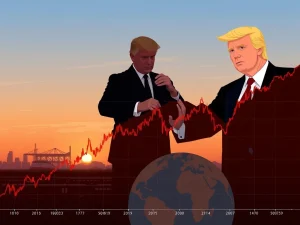Unveiling Grok 3 for Crypto Trading Automation: Successes and Pitfalls

Are you intrigued by the prospect of effortless crypto trading? In the fast-paced world of cryptocurrency, even seasoned traders grapple with market volatility. This has led many to explore automation, and Grok 3, Elon Musk’s advanced AI model, has emerged as a tool of interest. While not designed specifically for trading, Grok 3’s data analysis and pattern recognition capabilities have inspired traders to test its potential for automated strategies. The core idea is compelling: leverage Grok 3 to make data-driven decisions, removing emotional biases that often lead to trading missteps. But does automating crypto trading with Grok 3 truly deliver? Experiences vary, with some traders reporting impressive gains and others encountering unpredictability, particularly in turbulent markets. This article dives deep into the realities of automating crypto trades using Grok 3, exploring both triumphs and challenges, and providing you with actionable insights to optimize your approach.
Decoding Grok 3: An AI Ally in Crypto Trading Automation
Grok 3, developed by xAI, is an AI model primarily focused on natural language processing. However, its ability to process information and identify trends is attracting attention from traders seeking to refine their crypto trading strategies. Unlike traditional, rule-based trading bots, Grok 3 offers a flexible approach, capable of analyzing diverse data sources and uncovering subtle patterns that might escape conventional systems. This adaptability is key in the volatile crypto market.
Why are Traders Exploring Grok 3 for Crypto Trading Automation?
Grok 3’s allure in the crypto sphere stems from its capacity to handle intricate data, a significant advantage in markets swayed by unpredictable events and rapid shifts in market sentiment. Here’s why traders are seeing potential in Grok 3:
- Identifying Market Sentiment Trends: Crypto markets are famously driven by emotions – FOMO and FUD. Grok 3 can analyze social media, news, and online discussions to gauge evolving sentiment, a crucial indicator of crypto volatility.
- Recognizing Hidden Patterns: Grok 3’s machine learning prowess allows it to detect subtle links between various indicators that traditional bots might miss. For example, it could correlate rising social sentiment with increased whale activity to predict bullish momentum.
- Flexible Analysis Based on Prompts: Instead of rigid rules like “Buy when RSI drops below 30,” Grok 3 enables traders to create sophisticated strategies using natural language prompts, offering a more nuanced approach to crypto trading automation.
What Actually Happens When You Automate Crypto Trades with Grok 3?
It’s crucial to understand that Grok 3 isn’t a ready-to-use crypto trading bot. It doesn’t directly execute trades or connect to exchanges on its own. Instead, it serves as a powerful tool to help traders develop smarter, faster, and more adaptable automation systems. Grok 3 is being utilized to streamline the creation and testing of crypto strategies, from generating trading logic to analyzing market sentiment.
Traders are leveraging Grok 3 to generate functional code for bots, eliminating the need for manual scripting of every detail. For instance, by prompting Grok 3 to create token buy/sell logic with specific parameters like slippage, take-profit levels, and gas fees, users receive a script ready to integrate with DeFi platforms or expand using APIs like 0x and Uniswap. Some are even building comprehensive bots tailored to specific tokens or niche strategies.
Consider this example prompt given to Grok 3, aiming to develop a high-frequency trading bot framework for Solana (SOL):
Grok 3 Prompt: High-frequency trading bot framework for Solana (SOL)
Grok 3’s Response: High-frequency trading bot framework for Solana (SOL)
Below is a structured outline for a high-frequency trading bot framework designed for Solana (SOL), focusing on one-minute price fluctuations, risk management and trade execution. This outline provides a modular structure with placeholders for key components, avoiding specific implementation details as requested.
- Core configuration
Purpose: Define global settings and constants for the bot.
Components:
- Solana network endpoint (e.g., mainnet RPC URL)
- Wallet configuration (private key or keypair for trading)
- Trading pair (e.g., SOL/USDC)
- Timeframe (one-minute candlestick data)
- Trade size ($100 per position)
- Max trades (10 concurrent or sequential positions)
- Profit target ($50 total)
- Max loss per trade ($20)
- Data acquisition module
Purpose: Fetch and process real-time SOL price data.
Components:
- WebSocket connection to Solana blockchain or exchange API (e.g., Serum, Raydium, or centralized exchange like Binance)
- 1-minute OHLCV (Open, High, Low, Close, Volume) data stream
- Data buffer for storing recent price history
- Error handling for connection drops or latency
- Volatility analysis module
Purpose: Assess SOL’s price volatility to inform trade decisions.
Components:
- Placeholder: Calculate short-term volatility (e.g., standard deviation or ATR over one-minute candles)
- Placeholder: Define volatility thresholds (e.g., high/low volatility states)
- Output: Volatility score or signal to adjust trade frequency/size
- Trade signal generator
Purpose: Generate buy/sell signals based on price fluctuations.
Components:
- Placeholder: Simple momentum strategy (e.g., price crossing a short-term moving average)
- Placeholder: Filter signals using volatility analysis
- Signal validation (e.g., avoid over-trading within one-minute window)
- Output: Buy/sell signal with timestamp
- Risk management module
Purpose: Enforce risk controls and position limits.
Components:
- Position size calculator (fixed at $100 per trade)
- Max loss check ($20 per trade stop-loss)
- Total profit/loss tracker (halt at $50 profit or after 10 trades)
- Concurrent trade limiter (cap at 10 active positions)
- Emergency stop (pause bot on extreme volatility or connectivity loss)
- Trade execution module
Purpose: Execute trades on the Solana blockchain or exchange.
Components:
- Placeholder: Build Solana transaction (e.g., swap SOL for USDC via a DEX like Raydium)
- Order type (market order for speed in one-minute timeframe)
- Slippage tolerance (e.g., 0.5% max slippage)
- Transaction signing and submission
- Confirmation listener (await transaction finality)
- Error handling (e.g., retry on failed execution)
- Performance monitoring module
Purpose: Track and log bot performance in real time.
Components:
- Trade log (entry price, exit price, profit/loss, timestamp)
- Running total profit/loss calculator
- Performance metrics (e.g., win rate, average trade duration)
- Alert system (notify on profit target, max loss, or errors)
- Main control loop
Purpose: Orchestrate bot operations in a continuous cycle.
Components:
- Initialize bot (load config, connect to data feed)
- Loop: Fetch one-minute price data
- Analyze volatility
- Generate trade signal
- Apply risk management checks
- Execute trade if conditions met
- Update performance metrics
- Exit conditions (profit target hit, max trades reached, or manual stop)
- Shutdown and cleanup
Purpose: Safely terminate the bot and finalize operations.
Components:
- Close open WebSocket connections
- Finalize pending transactions
- Save trade log and performance summary
- Release resources (e.g., memory, wallet connections)
Caution! The above is a tailored outline shaped by the user’s prompt, targeting one-minute price fluctuations, risk management and trade execution. Its output varies with prompt detail, as specificity sharpens results. Moreover, placeholders like volatility analysis await user customization, reflecting Grok 3’s adaptive learning. It’s a conceptual guide, not code, and success hinges on implementation and market conditions. For deeper refinement, such as Solana-specific tweaks, users can provide more context. Grok 3 adjusts using their input and its sights.
Let’s explore the essential steps for setting up Grok 3 for AI trading bot automation.
Setting Up Grok 3 for AI-Powered Crypto Trading Automation: A Step-by-Step Guide
Implementing Grok 3 for crypto trading automation requires a strategic approach, as it’s not a plug-and-play solution. It demands careful setup, integration, and personalization. Here’s a practical guide:
Step 1: Selecting a Compatible Trading Platform
Since Grok 3 lacks direct exchange connectivity, it needs to integrate with third-party platforms that offer API automation. Consider platforms like:
- 3Commas: Ideal for executing trades through automated strategies.
- TradingView: Useful for generating trade signals using Pine Script.
- CryptoHopper: Provides tools for building custom strategies with API integration.
Ensure your chosen platform has robust API support for trade execution, risk management, and performance tracking.
Step 2: Integrating Grok 3 with Your Chosen Platform
Direct integration is not possible, so creative solutions are needed:
- API Integration via Automation Tools: Platforms like Zapier or Make.com can bridge Grok 3’s analysis with trading platforms.
- Custom Python Scripts: For technically inclined traders, Python scripts can process Grok 3’s insights and execute trades based on its recommendations.
- No-Code Automation Tools: Services like IFTTT can trigger basic trading actions based on Grok 3’s market sentiment analysis.
Step 3: Defining Robust Trading Strategies with Grok 3
Grok 3’s effectiveness relies on well-defined strategies. Unlike traditional bots that focus solely on technical indicators, Grok 3 can incorporate a wider range of factors:
- Technical Indicators: RSI, MACD, Bollinger Bands, etc.
- Sentiment Analysis: Social media trends, influencer opinions, and news headlines.
- On-chain Data: Whale activity, exchange flows, and large wallet movements.
Step 4: Backtesting Your Strategies Rigorously
Before deploying any strategy live, backtesting is crucial to assess its performance using historical data. Backtesting helps to:
- Evaluate Signal Accuracy: Determine how often Grok 3’s signals lead to profitable trades.
- Detect False Signals: Identify if Grok 3 generates excessive signals in volatile or quiet markets.
- Refine Strategy: Fine-tune parameters like RSI levels, sentiment scores, and exit conditions.
Tools like TradingView and CryptoQuant can be invaluable for backtesting.
Step 5: Implementing Critical Risk Management Controls
Even with AI insights, crypto markets are unpredictable. Risk controls are essential to minimize potential losses:
- Stop-Loss Orders: Automatically close trades if prices move against you beyond a set limit.
- Position Limits: Restrict trade sizes to reduce exposure in uncertain conditions.
- Trailing Stops: Secure profits during uptrends while limiting downside risk.
Example of a risk control prompt for Grok 3: “Write code to manage token buys and sells with parameters for priority fees, slippage, and take-profit mechanisms.”
Step 6: Continuous Monitoring and Strategy Refinement
Grok 3’s strength is its adaptability, but it requires ongoing monitoring for optimal performance. Regularly review:
- Performance Data: Track win rates, profit margins, and signal accuracy.
- Market Conditions: Adjust strategies for major market shifts like regulatory changes or macroeconomic events impacting market sentiment.
Pro tip: Regularly revisiting and refining your prompts to Grok 3 can significantly improve long-term strategy outcomes.
Limitations to Consider with Grok 3 for Crypto Trading Automation
Despite its advantages, Grok 3 has limitations that traders must be aware of:
- Data Loss: In crypto trading automation with Grok 3, reports indicate occasional data loss, miscounting of words, and inaccurate time references. This can be detrimental in fast-moving markets, leading to inaccurate signals and delayed responses.
- No Direct Exchange Integration: Unlike dedicated trading bots, Grok 3 requires reliance on third-party platforms for trade execution, adding complexity.
- Forgetfulness: Some users report “retrograde amnesia,” where Grok 3 forgets previous sessions, requiring traders to start fresh each time, which is inefficient for strategy development.
- Potential Bias: Grok 3 might produce biased responses based on skewed or incomplete data sources, which can lead to misleading market sentiment analysis and poor trading decisions.
- Slower Execution Speed: Grok 3’s prompt-based processing might cause trade signals to lag behind rapid price movements, affecting profitability in high-speed trading.
- Prompt Dependency: Grok 3’s accuracy is heavily dependent on the quality of prompts. Vague prompts often yield unreliable results, demanding precision in strategy formulation.
Final Thoughts: Navigating Crypto Trading Automation with Grok 3
Grok 3 and similar AI systems offer powerful tools for automating crypto trading strategies. However, caution is paramount. Their performance is heavily influenced by data quality and programmed strategies. Unexpected market changes or flawed inputs can lead to significant losses. Remember, AI lacks human intuition and may struggle with unforeseen events. Therefore, relying solely on AI without human oversight is risky. Always test strategies with small amounts and seek expert advice before committing significant capital. While Grok 3 offers exciting possibilities for crypto trading automation, a balanced approach combining AI insights with human judgment is crucial for navigating the complexities of the crypto market successfully.








